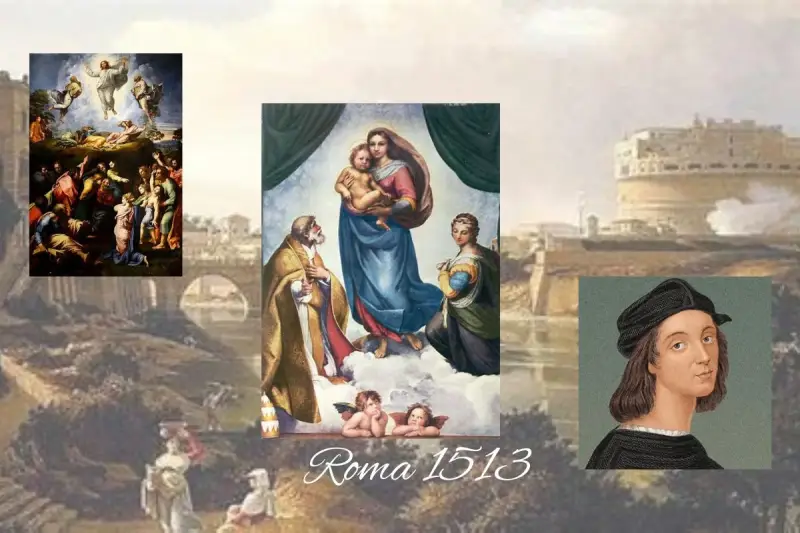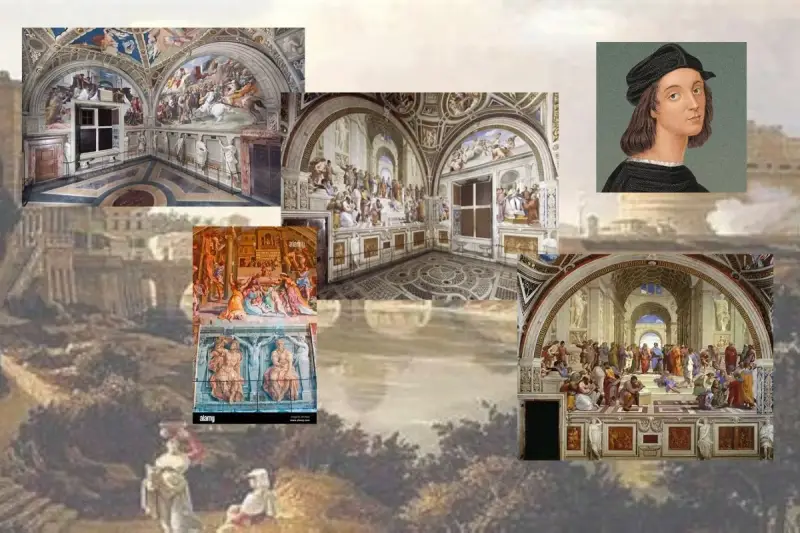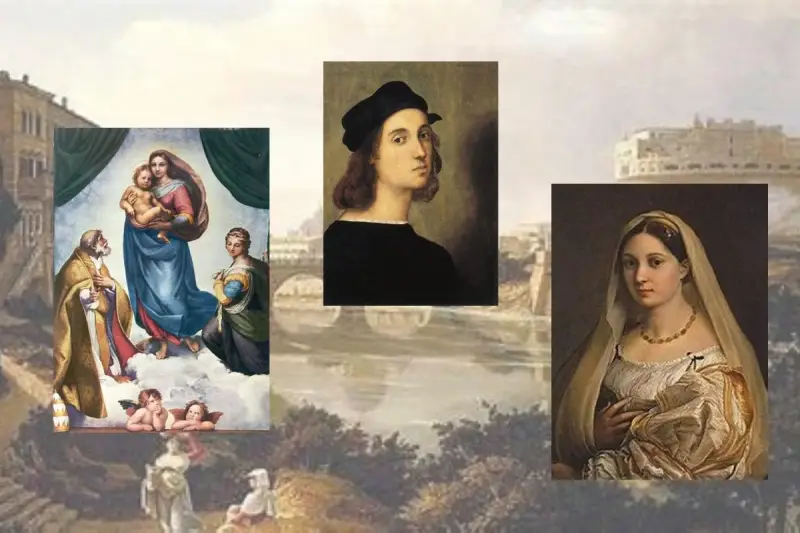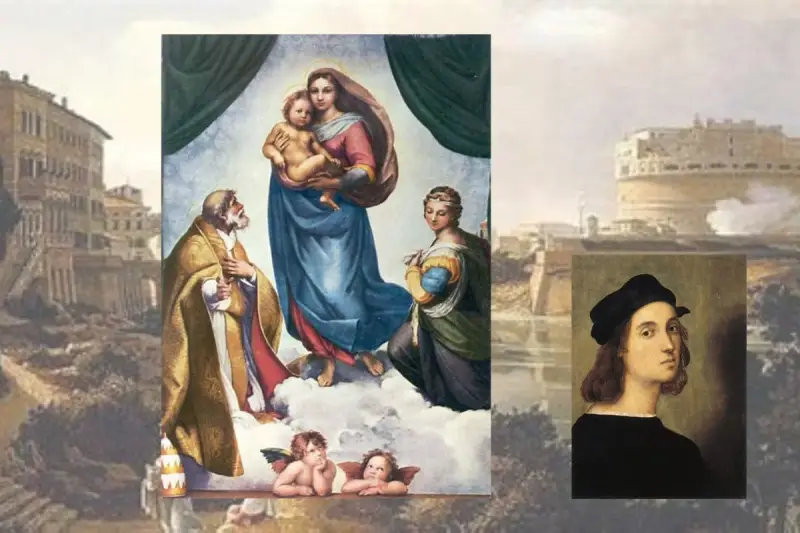
In a city of power and beauty, one artist seeks the divine in the woman he loves.
Rome, 1513: Popes, politics, street life, and an artist whose charm was as legendary as his brush.
We'll begin in Rome, where Raphael was busily working for Pope Julius II.
Part one:
Introduction: A City of Marble, Myths, and Mischief.
Rome in 1513 wasn't simply a place of religion; it was also a place of ambition.
The sun-drenched piazzas were full of painters, architects, lords, pastors, philosophers, businessmen, and street sellers, all of whom added their dreams to the city's constant beat.
In the middle of all this beautiful pandemonium, Raphael Sanzio strolled by. He was stylish, considerate, and charming in a way that made even the most difficult customers feel at ease.
Michelangelo fought with marble and politics, while Leonardo sought the mysteries of nature. Raphael, on the other hand, learned how to lift the spirit without losing the tenderness of the human heart.
The Sistine Madonna is his best work, and it's apparent that he meant it.

Rome’s Grand Commission: When the Pope Came Calling.
Pope Julius II called Raphael to see him, and by then the young artist was already well-known because of the Stanze of the Apostolic Palace. However, receiving a significant commission from the Pope himself was unprecedented. That was like getting the keys to the kingdom in the Renaissance.
Raphael said with modest satisfaction, "His Holiness gave me this job as part of his vision for the Church." "Getting a commission like this is always an honour, and maybe it's a sign that he has forgiven me for having too many fans in Rome."
Raphael accepted compliments with the same sarcasm and soft touch he applied to colours.
This time, Julius II requested a giant altarpiece for the San Sisto church in Piacenza, not a fresco—something holy, private, bright, and clearly Raphael.
An excerpt from the alleged interview...
Interviewer: Thank you, Maestro Raphael, for speaking with us. You're currently working on the Sistine Madonna. Please give your comments on how this project originated. Did Pope Julius II's commission surprise you?
Raphael: It is a joy to discuss the artwork. His Holiness entrusted me with this work as part of a larger vision for the glory of the Church. Unsurprisingly, his confidence in my abilities had increased over the years, especially following my work on the Apostolic Palace's Stanze di Raffaello.
However, such a commission is usually a great honour. Regarding competition, Rome is never short of talent, but this time, the Pope seems confident in his decision.

Margherita Luti: The Quiet Flame Behind the Madonna
Raphael would never say it in public, but his inspiration and love, Margherita Luti, gave life to his Madonna.
Raphael loved her with a mix of romance, compassion, and artistic respect since she was the daughter of a baker and a lady of elegance rather than position.
He said, "Faces on the street inspire me." "But occasionally, the person you love becomes the reason for every move and every light."
The Madonna's serene face softened Margherita's delicate features. Her warmth brought Raphael's image of maternal grace to life. People in Rome muttered behind Raphael's back, but he only grinned.
An excerpt from the alleged interview...
Interviewer: Who or what inspired the depicted characters in this painting? Did you have a muse for Madonna herself?
Raphael: In my art, the Madonna has always taken on a hallowed and idealized shape, but for this piece, I wanted her to represent heavenly grace and maternal love. My inspiration is typically life itself—faces I see on the street or the shapes of someone I care about. Margherita Luti, my cherished muse,'s delicate expressions may have inspired the Madonna's tranquillity, but always with respect for the sacred.

How the Sistine Madonna Was Born: Heaven Meets Earth
The result was a piece of music that seemed both holy and human, both awe-inspiring and easy to understand. The Madonna walks forward as if coming from another world, calm yet grounded.
The Child looks straight at the spectator, pulling them into the holy moment.
Saint Sixtus and Saint Barbara stand on each side of them, like moral guides.
And below them, the now-famous cherubs lean lazily on the railing. They are naughty and difficult to resist, and Raphael got the idea from two children who were imitating his drawings.
Raphael stated, "Their silliness made everyone in the studio laugh." "So into the painting they went—Rome's most charming troublemakers."
Those cherubs were supposed to be a fun addition, but they would eventually become some of the most famous faces in all of art history.
An excerpt from the alleged interview...
Interviewer: The composition is stunning. What was the Pope's job, and how did you get to this arrangement?
Raphael: The Pope wanted an altarpiece for the San Sisto cathedral in Piacenza, and I knew it had to inspire awe and devotion. The Madonna is important, serving as a bridge between the heavens and the earthly sphere. The infant looks straight at the spectator, inviting them into the precious moment. Saint Sixtus and Saint Barbara, flanking her, act as advisors, each representing humility and virtue. The cherubs below provide lightness and surprise, enticing even the most uncomplicated hearts upward. As for the many children's faces in the backdrop, what more remarkable emblem of divine purity and innocence?

Here we conclude the first part of our journey to Rome in 1513.
As always, the continuation will be in the next episode.
Yours, Nik.
P.S. It is improbable that any artist today has never seen drawings of Raphael's work.
It is impossible to say if Raphael's work impacted current painters, but his contribution to the growth of painting is undeniable.
I recommend the Artwork Gallery page on artbyelenag.com for those interested in contemporary painting.
See you soon, my grateful reader.
Nik.
Add comment
Comments